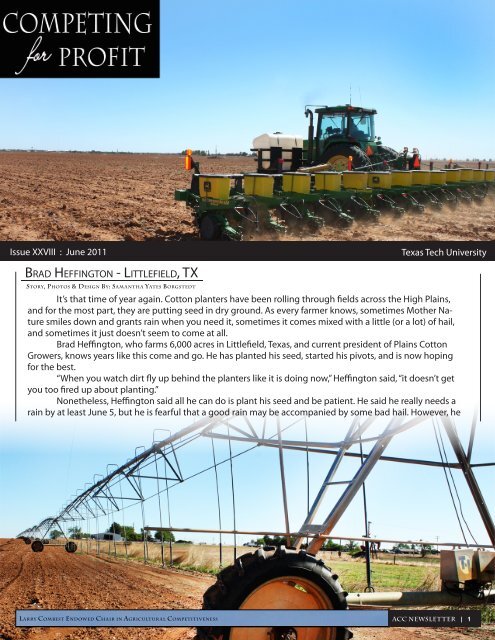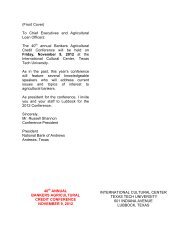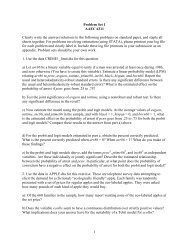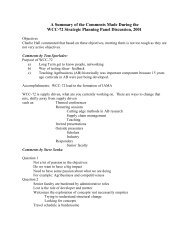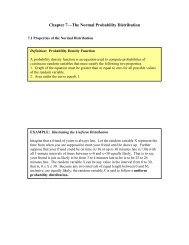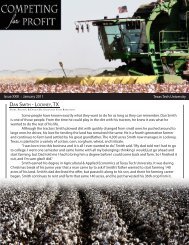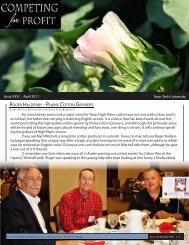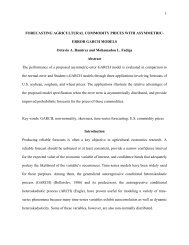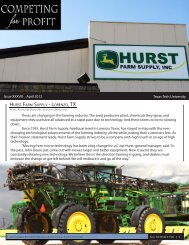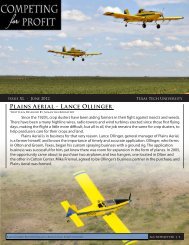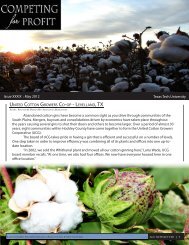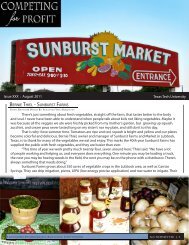Brad Heffington - Texas Tech University
Brad Heffington - Texas Tech University
Brad Heffington - Texas Tech University
Create successful ePaper yourself
Turn your PDF publications into a flip-book with our unique Google optimized e-Paper software.
Issue XXVIII : June 2011<br />
<strong>Brad</strong> <strong>Heffington</strong> - Littlefield, TX<br />
<strong>Texas</strong> <strong>Tech</strong> <strong>University</strong><br />
Story, Photos & Design By: Sa m antha Yates Borgstedt<br />
It’s that time of year again. Cotton planters have been rolling through fields across the High Plains,<br />
and for the most part, they are putting seed in dry ground. As every farmer knows, sometimes Mother Nature<br />
smiles down and grants rain when you need it, sometimes it comes mixed with a little (or a lot) of hail,<br />
and sometimes it just doesn’t seem to come at all.<br />
<strong>Brad</strong> <strong>Heffington</strong>, who farms 6,000 acres in Littlefield, <strong>Texas</strong>, and current president of Plains Cotton<br />
Growers, knows years like this come and go. He has planted his seed, started his pivots, and is now hoping<br />
for the best.<br />
“When you watch dirt fly up behind the planters like it is doing now,” <strong>Heffington</strong> said, “it doesn’t get<br />
you too fired up about planting.”<br />
Nonetheless, <strong>Heffington</strong> said all he can do is plant his seed and be patient. He said he really needs a<br />
rain by at least June 5, but he is fearful that a good rain may be accompanied by some bad hail. However, he<br />
Larry Combest Endowed Chair in Agricultur al Competitiveness<br />
ACC NEWSLETTER | | 1
ACC NEWSLETTER | 2<br />
Larry Combest Endowed Chair in Agricultur al Competitiveness<br />
acknowledges that dealing with the weather is<br />
a major part of a farmer’s business, and so he<br />
will take it as it comes.<br />
<strong>Heffington</strong> said although bad years<br />
come along with the good, he remains thankful<br />
that in 1989 a small town banker took a chance<br />
on him, which allowed him to do what he continues<br />
to love today, farm.<br />
“I was a junior at <strong>Texas</strong> <strong>Tech</strong> when some<br />
land became available for me to farm,” <strong>Heffington</strong><br />
said. “I tried to get a loan from several<br />
places with no luck. Mr. Lee decided to take a<br />
shot on me, and I am sure glad he did.”<br />
James Lee, of the First National Bank of<br />
Littlefield, must have seen a drive in <strong>Heffington</strong><br />
that has continued to grow and prosper to this<br />
very day. Besides striving to learn and remain<br />
educated on seed, fertilizer, and equipment,<br />
<strong>Heffington</strong> has worked hard to gain knowledge<br />
about the marketing side of his operation.<br />
<strong>Heffington</strong>, who graduated from <strong>Texas</strong><br />
<strong>Tech</strong> <strong>University</strong> with a Bachelor’s of Business<br />
Administration and from the <strong>Texas</strong> A&M<br />
Master Marketer program, uses technical and<br />
fundamental analysis, and stays in tune with<br />
local and world markets. He said being able to<br />
market his cotton has earned him income and<br />
success. He went on to say marketing is a very<br />
important aspect of his business, and he tries to<br />
take advantage of every opportunity he can to<br />
capture the best prices for his cotton.<br />
<strong>Heffington</strong> earned an average selling<br />
price of $1.08 on his cotton last year, selling<br />
some towards the end for $1.50. He said everything<br />
kept falling in place for him as he grew<br />
and sold his cotton. Rain came pretty steadily,<br />
and prices rose. And although the growing<br />
season may not be as favorable this year as last,<br />
<strong>Heffington</strong> said he continues to see prices staying<br />
strong.<br />
“If crops remain as dry as they are now,<br />
dryland acres may not be there and our irrigated<br />
production is liable to decrease, which<br />
means prices this fall could stay up,” <strong>Heffington</strong><br />
said. “However, those high prices won’t do<br />
much good if we don’t have cotton to sell.”<br />
<strong>Heffington</strong> said with the rising input<br />
costs farmers have to deal with, they cannot<br />
stand to sell cotton for 60 to 70 cents anymore.<br />
Seed, fuel, labor, fertilizer, equipment, technology,<br />
they have all gotten significantly more<br />
expensive in a short amount of time, making<br />
every cent count to the farmer.<br />
“In order to be successful in farming you<br />
must figure out what pays and what doesn’t,”<br />
<strong>Heffington</strong> said. “Some technology may cost<br />
Andy Timmons planting grapes.
Larry Combest Endowed Chair in Agricultur al Competitiveness<br />
ACC NEWSLETTER | 3<br />
you a little more up front, but make you more in<br />
the end. Some may not. You just have to figure<br />
out what will be the most profitable on your farm<br />
and go with that.”<br />
<strong>Heffington</strong> has helped several equipment<br />
and technology dealers test their newest<br />
products on his farm. He has adopted a Case and<br />
John Deere cotton picker with on-board modulebuilding<br />
capabilities. He said that although the<br />
cost of these machines was significant, they have<br />
reduced his need for many other pieces of harvesting<br />
equipment, fuel, and labor.<br />
“I remember having boll-buggies, modulebuilders<br />
and strippers going everywhere,” <strong>Heffington</strong><br />
said. “We would have to hire on several more<br />
people to help run everything, and hope everyday<br />
that everyone showed up. With these pickers it<br />
takes one guy to run them, some fuel, and that is<br />
it.”<br />
<strong>Heffington</strong> also uses Trimble precision agricultural<br />
products that utilize 27 satellites enabling<br />
him to stay within a half-inch variance on all of his<br />
fields. <strong>Heffington</strong> gives credit to his wife Kim, their<br />
three sons, and his three employees, all of which<br />
have worked for him close to 20 years, for being<br />
knowledgeable of the technology and his farm in<br />
general. He said good help is not always easy to<br />
find, and he is lucky to have had such great help
ACC NEWSLETTER | 4<br />
Larry Combest Endowed Chair in Agricultur al Competitiveness<br />
from his employees and family for many years.<br />
While <strong>Heffington</strong> can rely on good help<br />
through what looks to be a tough year, he is worried<br />
about his limited water and dryland crops. Although<br />
the majority of <strong>Heffington</strong>’s fields are irrigated, he<br />
said the irrigation is set up to supplement rainfall, as<br />
most of the High Plains irrigation is set up to do. His<br />
wells are continuing to pump an adequate supply of<br />
water for now, but he needs to continue to be cautious<br />
with his water output to ensure that enough<br />
water will be available in the future, and to do that<br />
<strong>Heffington</strong> needs timely and adequate rains.<br />
“The weather and policy you cannot control,”<br />
<strong>Heffington</strong> said, “which creates lots of challenges for<br />
farmers. We may have better seed varieties and technologies<br />
for using water, but no matter what, we still<br />
need the rain.”<br />
Along with rain, <strong>Heffington</strong> said farmers also<br />
need good policy.<br />
“Farm policy is geared to small farmers,” <strong>Heffington</strong><br />
said. “We aren’t small farmers anymore. We are<br />
big businesses, real businesses, and we are a very few<br />
feeding and clothing a lot of people.”<br />
<strong>Heffington</strong> said in order to continue supplying<br />
food and fiber for the world, policy must be written<br />
that provides valuable safety nets for farmers and is<br />
focused on keeping U.S. commodities competitive in<br />
the international marketplace.<br />
“We are coming off a good year,” <strong>Heffington</strong><br />
said. “We made a good crop, received some good<br />
prices, and saw our local economies benefit from all<br />
of that. The thing we must remember is that at the<br />
end of the day it all comes down to the number one<br />
economic rule: supply and demand. If textile mills<br />
need the cotton, then we will see a demand and<br />
good prices. I just hope we have the cotton to supply<br />
them with.”
Comments from the Chair<br />
Mr. <strong>Heffington</strong> is the prototype for the next<br />
generation farmer. <strong>Tech</strong> savvy and farming<br />
oriented can be used to describe him. But,<br />
perhaps a better description is a “complete<br />
package.” <strong>Brad</strong> knows how to grow a crop for<br />
sure, but he is also a great marketer and a great<br />
advocate for agriculture. It is his marketing,<br />
though, that should be a good example for<br />
remaining competitive. As everyone knows,<br />
cotton markets have experienced big increases in<br />
market volatility in recent years. To protect<br />
yourself from downturns and take advantage of<br />
good prices takes time, effort, and knowledge.<br />
One certainly does not have to be an ‘expert’ in<br />
cotton prices...I am not sure any of us are<br />
‘experts’...but careful attention to potential<br />
opportunities and seeking out information about<br />
how those options work (or do not work) for your<br />
operation are critical to long-term success.<br />
<strong>Brad</strong> has definitely exemplified the meaning<br />
of “marketing.” His academic training helped, of<br />
course. But it has been his “can do” attitude that<br />
has led him to seek out the additional training<br />
and spend the time learning the markets and risk<br />
management options that are available to him.<br />
Of course, there are varying degrees of<br />
sophistication, and more sophisticated marketing<br />
strategies take<br />
more time to<br />
execute. All<br />
producers are not<br />
suited to these<br />
approaches, which<br />
is certainly fine.<br />
But, with the extra<br />
time and energy<br />
comes extra<br />
earnings. So, the less<br />
Dr. Darren Hudson, Chair<br />
time you spend, the less you will make, generally.<br />
<strong>Brad</strong>, of course, is first concerned about making<br />
a crop. But, his success does not stop with yield.<br />
Marketing is his passion and is also a key factor<br />
in his competitiveness.<br />
Larry Combest Endowed Chair in Agricultur al Competitiveness<br />
ACC NEWSLETTER | 5


